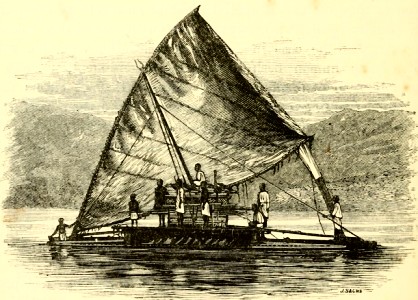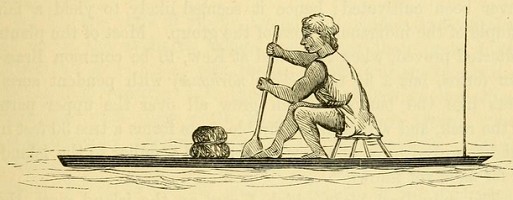
A Fijian Double Canoe
(From a photograph)
CAPE YORK.
Page 361
Cape York is a sort of
emporium of savage weapons and ornaments.
Pearl shell-gathering
vessels (Pearl shellers as they are called) come to
Somerset with crews which they have picked up at all the
islands in the neighbourhood, from New Guinea, and from
all over the Pacific, and they bring weapons and
ornaments from all these places with them.
Moreover, the Murray Islanders visit the port in their
canoes, and bring bows and arrows, drums, and such
things for barter.
The water police stationed at Somerset deal in these
curiosities, buying them up and selling them to
passengers in the passing steamers, or to other
visitors.
Hence all kinds of savage weapons have found their way
into English collections, with the label "Cape York,"
and the Northern Australians have got credit for having
learnt the use of the bow-and-arrow.
I believe that no Australian natives use the bow at all.
[The Phillipines]
Page 399
The most interesting feature about pile-dwellings seems
to be their very wide geographical extension.
Representatives of almost all races of man seem to have
arrived at the same expedient, apparently not by any
means a simple one, independently of one another.
There are the well-known Pfhalbauten of Switzerland, in
South America the similar houses of the Cuajiro Indians,
on the Gulf of Maracaibo.
In North America the Haidahs on the north-west coast
construct similar habi-
Page 400
tations.
Commander Cameron lately observed similar dwellings in
Lake Mohrya, in Central Africa.*
In New Zealand, the Lake Pas, which were mostly used as
store-houses, are known from the Rev. Eichard Taylor's
description.**
In this case, piles were driven into the bottom of the
lake, and the interstices filled in with stones and mud,
so as to form a platform.
There are the well-known New
Guinea pile-dwellings, such as seen by us at Humboldt
Bay, and there are also the pile- dwellings of all the
Malay races.
The Gilbert Islanders construct also houses raised on
piles, and a number of these natives from the island of
Arorai, who were taken to Tahiti, to serve as labourers
on cotton estates, have put up houses of this kind for
themselves in the latter islands, amongst the very
different dwellings of the Tahitians themselves.
It seems probable that the idea of a pile dwelling has
in many cases arisen from the escape of natives from
enemies by getting into a canoe or raft, and putting off
from shore into a lake or the sea, out of harm's way.
If the attacked had to stay on such a raft or canoe for
some time, they would anchor it in shallow water with
one or more poles, as the Fijians do with their canoes
on rivers, and hence might easily be derived the idea of
a platform supported on piles.




